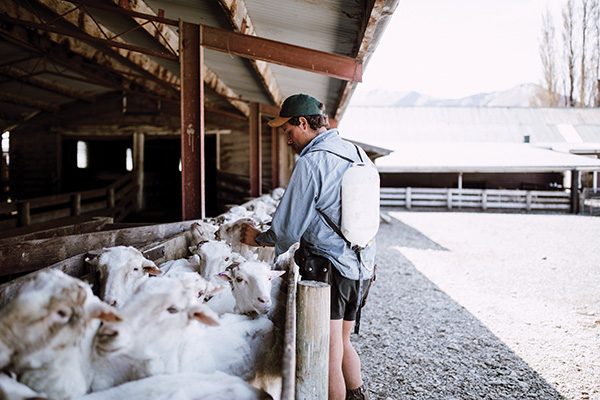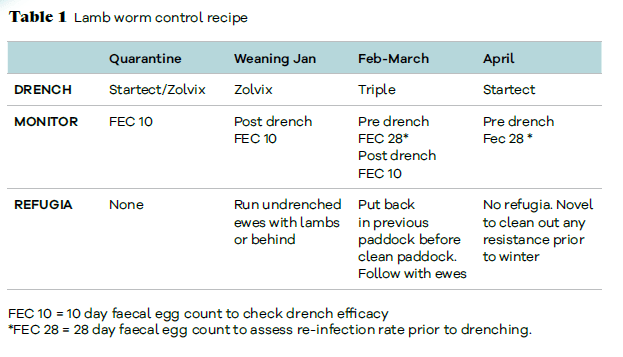Controlling dark forces
The traditional drench families that have served fine wool farmers well are losing efficacy, but drench-resistant internal parasites can still be fought, writes Dave Robertson.

Rabbits, gorse, hieracium, stray balage wrap and internal parasites are some of the dark forces that require attention for most fine wool farms. Unlike the yellow gorse flowers of spring or the alarming number of new bunnies scattered around the sunny faces, drench-resistant parasites are not easy to visualise and motivation to intervene early is harder to summon when there doesn’t appear to be a problem.
Farmers have seen the benefits of good preventative worm control programmes over the past three decades. For some extensive flocks, long-acting drenches have been miraculous and the 28-day drenching programme has avoided lambs falling to bits with worms in the autumn.
However, the three traditional drench families that have served us well for the last 40+ years are now losing efficacy and production consequences are beginning to reveal themselves. Triple drench resistance in various shapes and forms is now commonplace and likely to be present at most store lamb sales this coming season.
Confronting this drench resistance reality is based around:
- Avoiding parasites through use of forages and planned grazing strategies
- Feeding stock better so they handle it
- Monitoring of parasite challenge and drench efficacy
- Genuine integration of lamb finishing with cattle and adult stock
- Leaving some capital stock undrenched and using these behind or with lambs (refugia)
- Breeding more robust animals that handle a worm challenge
- Strategic use of effective drench families and less whole flock treatment with long-acting drenches.
- A diagnosis of triple drench resistance is not the end and for some farms it is an opportunity to rejig stocking policies, forage systems and review habits. In most cases when changes are made, stock health improves and so does productivity. It is not even the end of triple drench use. The resistance status fluctuates throughout the season and can be different on different parts of the farm.
- For farms where drench resistance is diagnosed and farmers make no changes, the issues of poor stock performance and ill thrift re-occur in the autumn. April and May seem to be the “hot months” where most worm and drench issues surface.
- The issue with closed breeding flocks is sourcing/finding susceptible worm populations to redistribute through the hot areas on the farm. This is a confronting concept for most. But those farmers who are positive in their mindset when meeting the challenge of drench failure will find a way to make this work.
The mundane truth is that better fed ewes in better body condition don’t suffer the effects of parasitism the same. The mini-revolution of fine wool sheep has been selecting for more fat and carcase. This will have added benefits of supporting more robust sheep that will require fewer chemical inputs and handle parasite challenges – but they are a higher octane animal and drenches will still be required at times. Higher protein forages are also part of leaving the drench gun behind and having higher performing ewe flocks. Lucerne and clovers are the obvious sources of higher protein feed. The more of these legume forages that can be fed to ewes in early lactation the better the performance and the lower the impact of parasitism at this critical stage. Choice of lambing date, stocking rate and bold agronomy decisions are key to this.
We are fortunate to have two newer drench families that have propped things up for many farms. They are more expensive than traditional drenches, but there is nothing more costly than an ineffective drench where stock eat good feed, don’t grow, then start dying. These newer drench families are not going to remain effective for too long either if we don’t plan their use.
I am not meant to make recipes, but farmers seem to like summary tables after the crunchy theory.
For farms with some loss of triple efficacy or capsule leakage, see Table 1.
- Dave Robertson is a veterinarian with the Veterinary Centre Oamaru.

Parasite research programme
Development of a collaborative research programme is underway to help farmers manage internal parasites.
Beef + Lamb New Zealand (B+LNZ) is working with stakeholders to develop a research programme based on the outputs of a workshop held to gather feedback on long-term parasite management in the face of widespread drench resistance.
The workshop brought together national and international experts including farmers, vets, scientists, rural professionals, processing companies, government and industry bodies, and focused on tools farmers would need to manage internal parasites both sustainability and successfully.
Dr Cara Brosnahan, B+LNZ’s principal adviser Animal Health Research, says internal parasite management and drench resistance is a significant animal health concern.
“Farmers have relied on broad-spectrum anthelmintic drugs or drenches, but this reliance has resulted in parasites becoming resistant to drenches.
“While reversing drench resistance or farming successfully with drench resistance is possible, the approach may need to be tailored for different farm systems and will take time and commitment.”




